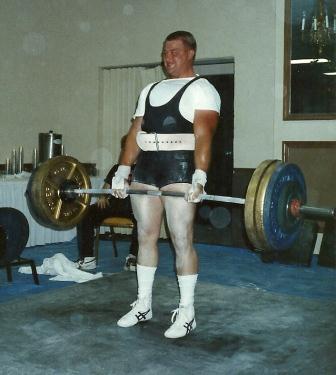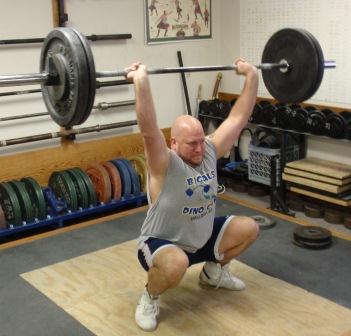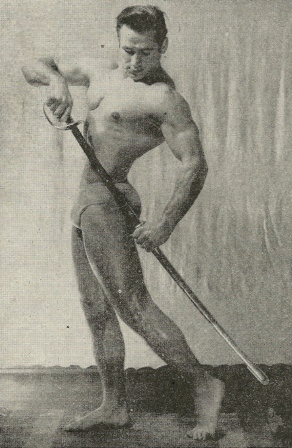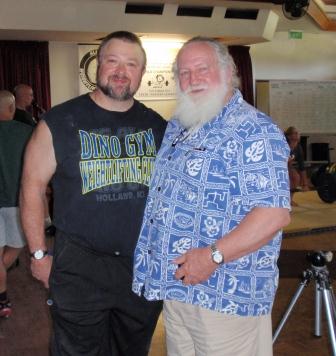My Friend Andy Goddard
by Steve Gardner
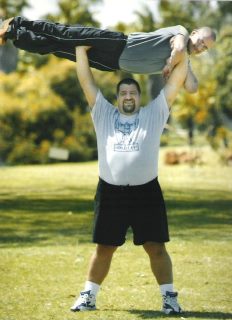
Steve Gardner lifting Andy Goddard overhead at the 2003 IAWA World Championships in Perth, Australia.
I have been asked to write a bit about the late Andy Goddard, as time moves on and newer members join, not everyone knows who he was and why we have a postal match named after him …….
I first met Andy 20 years ago when he wandered into my gym to watch an all round competition that was taking place. He lived locally and told me he had been in the Army for a number of years, where he was an Army light flyweight boxing champion. Andy was struck down with a stomach cancer and had an emergency operation, he nearly died, but he pulled through and was invalided out of the Armed Forces. This had all taken place a few years before he came to see me, and he told me he had been given the all clear from Cancer re occurring and thought he would like to start and do some training to see if he could lift with us.
I was delighted to help him and we cautiously worked together, but in no time it was obvious he was a strong little critter, and he took to weightlifting like a duck to water. Andy started to compete and he thrived on competition. Not only did Andy become a great champion, several times IAWA British Champion in the Open and many time World Champion in the Masters, he was a thoroughly nice man. He was a great friend to everyone, and always had a good word to say. Andy always helped to encourage new lifters in the sport and was the kind of guy who would do anything for anyone at the drop of a hat.
Andy’s favourite lifts were the Deadlift, Hacklift, Straddle and Trap Bar Deadlift, all of which he performed with more than 3 times bodyweight! Andy became a great friend of mine and my family too, he was like family to us. Andy was always there to help me every time we had a competition he would be helping me set up and move the weights, or collecting foreign lifters from the airport and helping me put them up. Andy was a quiet man, he wasn’t married but spent a lot of time treating and looking after others. It was the proudest moment for me to make the presentation to my friend when he was inducted into the IAWA(UK) Hall of Fame in 2007, this was a fitting reward for a true champion and holder of many, many records who had travelled the World and taken part in as many IAWA events as he could, a true all round weightlifter and supporter.
In 2008, Andy started to have some internal pain problems in his groin, though he insisted it did not stop him lifting, it continued to niggle at him and eventually the pains spread to his chest and back. Andy lifted in the World Championships in 2008 and was magnificent, but we knew all was not right. After countless visits to the Hospital they said they were not sure why he had the pain? We all worried in case there was something deeper, and in the end sure enough, eventually a scan showed a shadow near his spine. Andy went in and had some painful surgery on his back, the cancer was in his spine, it had returned after 20 years. Whilst operating they discovered that the cancer had spread to his organs and there was nothing anyone could do. They gave him six months, and that would have taken Andy up to his 50th birthday…he didnt make it, passing away just a few weeks before. It was so sad to see this wonderful light go out, we visited him and talked to him to the end, and were with him on his last day.
I had commented one time on Andys ‘Northern Ireland’ Campaign medal he had been awarded in the Army, having seen two tours of service over there in the early and mid 70’s, when he showed it to me I told him he should be justly proud of his achievements in such dangerous and difficult times. I was very moved when, after the funeral, his girlfriend said Andy had asked her to give the medal to me. I treasure it to this day.
We all miss Andy, and his belt and lifting boots remain at the gym so he is always with us. Andy loved competition, and the postal bearing his name is a fitting tribute to him.
